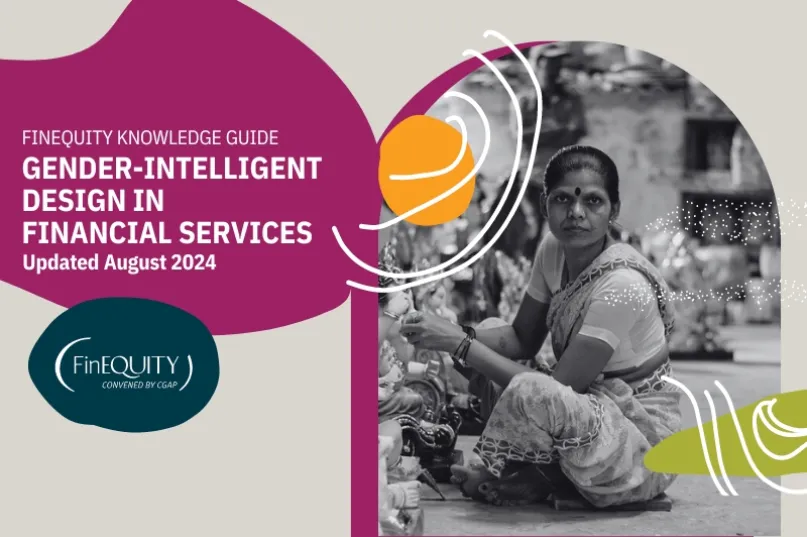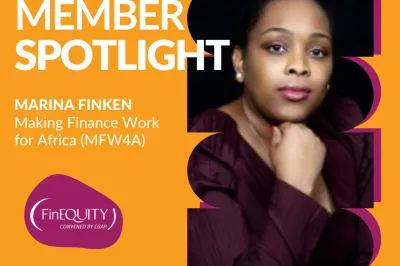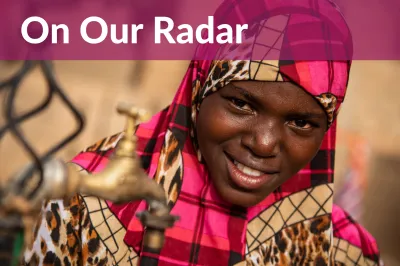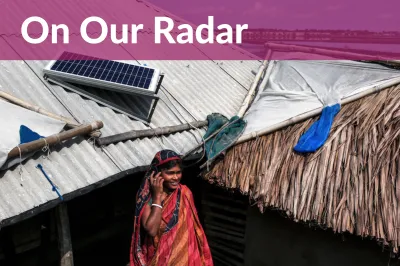FinEquity Knowledge Guide: Gender-intelligent Design in Financial Services

Women lead varied and complex lives and face numerous barriers to access to finance due to a plethora of factors such as their race, education, sexual orientation, location, and marital and socioeconomic status. They need financial services that meet their needs where they are and work for them.
Historically, financial services providers (FSPs) have generally considered their products and services to be “gender-neutral” – that is, equally valuable and applicable to men and women alike. However, if product design does not intentionally consider women’s realities, it is built for men—as demonstrated by the stubborn gender gap in financial and digital inclusion. This, alongside other strong evidence, has shown us that “gender-neutral” means “gender-blind.”
To tackle the stubborn gender gap in financial inclusion, some FSPs are becoming more deliberate by taking into account women’s lived realities to design financial services that create opportunities and lower barriers in their lives. To achieve greater financial inclusion and reap its benefits both for customers and the financial institutions themselves, some FSPs are taking a gender-intelligent design approach, drawing on quantitative and qualitative research and focusing on creating value for women. FSPs should not be concerned that products designed for women will not work for their male customers. There is much evidence demonstrating that what works for women works for men, but not the other way around. This is also in-line with the design principle that encourages building your offering with the hardest to reach customer in mind.
What is the purpose of this guide?
This updated [July 2024] guide brings together a sample of relevant resources on gender-intelligent design in women’s financial inclusion. The guide provides a starting point for understanding (i) why designing for women is critical; (ii) how to use segmentation approaches and user research when designing financial services; (iii) design principles and methodologies for adopting a gender-intelligent approach to design, and; (iv) available training resources.
Who is this guide for?
This guide was created for FSPs, policymakers, practitioners and others who are invested in creating financial services that address women’s needs. It provides these stakeholders with appropriate and practical design resources to help them improve the financial inclusion of the women client segments with which they work.
This Resource Guide has been updated in August 2024. FinEquity published the original version of this guide in June 2022 in collaboration with USAID. FinEquity intends to update it periodically with new resources. If you have or come across resources you think should be added, please send them to finequity@cgap.org. For even more resources on this topic, visit FinEquity's Resource Library.
Recommended Resources
The first set of resources focuses on making the case for why gender-intelligent design makes economic sense for financial service providers and examines how it is different from a “gender-blind” approach. Case studies, blogs and reports illustrate the opportunity women customers present and help providers to make the case for gender intelligent design with leadership.
Why Design for Women?
Revolutionizing Product Design in Financial Services
This report is useful for FSPs looking for a holistic, practical approach on how to undertake gender-intelligent product design effectively. It provides a set of key design principles along with practical case studies to equip financial inclusion stakeholders, including financial services providers, with the knowledge and confidence to use women-centered design to develop financial products and services that truly work for women.
Measuring the Value of the Female Economy: 2023 Edition [New]
This report, a collection of Financial Alliance for Women’s members’ financial data measuring the value of the female economy, is useful for FSPs looking to make the case for designing for women. The analysis incorporates more than 14,000 data points measuring the performance of 51 financial institutions, broken down by segment, product, and region. It also analyzes performance on internal gender diversity and includes insights into how institutions define, and serve, women-owned small and medium enterprises (SMEs). Note: You must create a login to access this resource on the Financial Alliance for women site.
Women Rising: A Study of the growing financial power of the women’s market in LAC, and what this means for financial institutions [New]
This study, which collected financial data from over 240 institutions in 13 countries, demonstrates how financial institutions in the LAC region are focusing their attention on women's banking to differentiate themselves and enhance their market position. It makes the case that there are opportunity costs to neglecting the women’s market as women are projected to control 75 percent of discretionary spending worldwide by 2028. While the business case for serving women is strong, institutions need to apply a gender lens to all aspects of the sales funnel (e.g. inclusive credit practices, alternative credit scoring) to design products that work for women. It is also available in Spanish.
Her Fintech Edge: Market Insights for Inclusive Growth [New]
This study, aimed at fintech firms, explores the representation of women within fintech portfolios and the factors influencing it. It investigates whether fintech firms actively target women customers and the strategies they employ. Additionally, it examines the performance of women customers compared to overall portfolios, considering loyalty, customer lifetime value, and default rates.
The Case for a Gender-Intelligent Approach: An Opportunity for Inclusive Fintechs
This blog offers a concise explanation of “gender-blind” and “gender-aware” approaches and discusses the problem with a gender-blind approach in perpetuating bias. It makes a clear argument for FinTechs to adopt gender-intelligent practices using case studies from two FinTechs in Sub-Saharan Africa, Paycode and Extramile, which highlight the potential of gender-aware approaches in this largely untapped markets.
Rural Women and Financial Inclusion [New]
This Guidance Note provides an overview of the main barriers and constraints that inhibit rural women’s financial inclusion and offers a step-by-step approach to analyzing the state of gender equality within a specific country or context. The purpose is to identify potential entry points for interventions that aim to increase rural women’s financial inclusion. It uses case studies to illustrate best practices for addressing these barriers to access to and use of financial services and provides tools for conducting gender-focused diagnostic assessments and analysis.
The following resources focus on user research and designing for segments of women with shared characteristics such as age, location, economic activity, or constraints. These resources demonstrate how categorizing women into subgroups - beyond the supposed segment of “women” - allows FSPs and development practitioners to consider the lives of the women they are designing financial services in a tangible way.
How to Design for Women: Segmentation and User Research
Why a Segmentation Strategy Matters for Serving the Women’s Market
This working paper draws on KIT’s work with Access Bank in Sub-Saharan Africa. It shares the methodology used to understand the needs and preferences of specific women customer segments and how FSPs can use a segmentation strategy to deliver more resonant financial services. It is useful for FSPs who want to demonstrate the need to design financial services with a more diverse women’s market in mind.
How to foster access to finance for women in the agri-food sector [New]
This publication provides insights, background and guidance on the challenges of promoting opportunities for women engaged in the agri-food sector to improve their economic and social resilience through access to financial services. This guidance is helpful for development practitioners working (or interested in working) on promoting women’s access to finance in the agri-food sector. Organized into seven chapters that provide foundational knowledge on the roles of women in the agri-food sector, chapter 4 presents several analytical tools and frameworks, such as segmentation of rural women, segmentation of small holder farmers, and gender assessment tools.
Informed Design Case Study Series
This series of case studies examines the role of design in digital financial services (DFS) for women focusing on examples where research findings have translated into design that has eased and encouraged women’s use of DFS. These case studies from Papua New Guinea, Uganda, South Africa, and Singapore are useful when looking for in-depth examples of a gender intentional research and design process for digital financial services.
How Can Financial Services Support Platform Work? Insights from Five Emerging Markets [New]
Drawn from in-depth qualitative and quantitative research across five countries, this paper’s insights focus on the potential for financial services to support platform workers and sellers in leveraging the opportunities and mitigating the risks emerging in platform work. CGAP conducted this primary research to shed light on the opportunities and challenges facing women platform workers and to better understand their financial profile and need for financial services.
The following resources enable the financial service providers, including fintechs and insurance providers, as well as policy makers and regulators to adopt or promote a gender-intelligent approach to design. Some resources stem from lessons learned during a specific program implementation, while others provide processes or frameworks for gender transformative design.
How to Design for Women: Principles and Methodologies
Gender and Design Toolkit
This comprehensive toolkit offers a step-by-step approach of the process required to transform gender norms within programming and avoid reinforcing existing gender inequalities. It is useful for FSPs looking to design products that meet women's specific needs by providing a foundational knowledge of gender dynamics and a user-friendly framework for gender-transformative design. It encourages practitioners to move their solutions from “gender negative” to “gender transformative” and to clearly establish what they are trying to achieve. Modules four (design research) and five (design direction) are particularly salient for creating financial services that resonate with women’s lives.
Fintechs Serving the Female Economy [New]
This report, directed towards fintech firms, is based on research with fintechs serving women customers. It showcases 25 startups that have created successful value propositions tailored to women customers and highlights how these fintechs have incorporated various elements of the gender-intelligent design throughout their sales funnels.
Policy Brief: Making Financial Products and Services Work for Women [New]
This policy brief focuses on the efforts policymakers, regulators, and financial service providers can make to foster inclusive design practices that cater to the diverse needs of women. After exploring the challenges faced by women in accessing and utilizing financial products and services, the brief shares case studies from Cambodia and India of successful initiatives employing women-centric product design principles, which resulted in increased engagement and usage of financial products among women.
Financial Products and Services for Women’s Financial Inclusion: A Policy and Regulation Design Toolkit [New]
This toolkit provides practical guidance for policymakers and regulators in formulating, designing, and implementing gender-transformative policies. Most financial policies and products and services are gender-neutral, or even gender-blind. Consequently, they disregard sociocultural norms restricting women’s mobility, ownership, agency, and usage of financial products and services.
Driving Better Business Results with Women’s Insurance [New]
This guide provides insurers with a six-step roadmap to build their own women’s market strategy. Steps include assessing the opportunity and building market intelligence, making the business case, creating customer value propositions, getting buy-in across all business units, refining distribution and marketing strategies, and measuring, evaluating and iterating the product. The guidance is informed by learnings from the IFC’s Women’s Insurance Program and the ILO’s Impact Insurance Facility work with the private sector to create sustainable women’s insurance markets across emerging economies.
Gender-Intentional Credit Scoring [New]
This guide presents a gender-lens analytical framework that lenders can use to determine whether lending decisions and outcomes in their portfolios differ by gender and, if so, how. This type of analysis of a loan portfolio can unveil potential gender-intentional strategies to grow both the total loan book and the share of women borrowers without increasing the portfolio’s credit risk. Because a gender-intentional approach can help lenders more accurately measure portfolio risk, such approaches not only can reduce the gender gap in access to credit, but also make good business sense, by allowing providers to increase their portfolios or reduce their losses.
Training Resources
Gender Analytics: Gender Equity through Inclusive Design Specialization
This five-course specialization on gender-based analytics teaches learners how to analyze products, services, processes, and policies with a gender lens to uncover hidden opportunities for innovation and improved effectiveness. The course consists of lectures (videos), readings, tests, graded assignments and quizzes, discussion forum, and peer feedback. There is also a self-paced option. It helps learners to: demystify key concepts related to gender and intersectionality, gather qualitative and quantitative data using ethical practices, use human-centered design and empathy to interpret insight, and employ rapid prototyping to design products, services, processes, or policies with beneficiaries or target audience, assess the impact of inclusive design solutions, and prepare organizations to execute Gender Analytics effectively.
Who is this course for and how to use it:
• Business leaders to use gender insights to innovate.
• Government & NGO professionals to do gender-based analysis (GBA+).
• Women’s studies experts for job-related applications.
• Business analytics experts to extend their skills to questions of equity.
• Human resources professionals to be partners for business innovation.
Online, $39 USD/ month, financial aid available; certificate for completing all five courses.
Course: How to Increase Lending to Women Using Machine Learning and Reject Inference [NEW]
This 6-hour video course equips both product owners and data scientists with the tools they need to address bias within credit evaluation processes at financial service providers. Within the course, participants learn to deploy algorithmic solutions to rectify biases in credit evaluations, focusing on the high-impact issue of mistakenly rejecting creditworthy applicants, often due to biases ingrained in evaluation models themselves. Users will walk away with:
- Working knowledge of where gender balance vulnerabilities emerge across credit processes.
- Language needed to discuss fair lending with colleagues, in any legal or policy environment.
- Two innovative methods to directly address bias in credit evaluation processes: matching algorithms and counterfactual learning.
- Working knowledge of Women’s World Banking’s approach to assessing bias and balance at various stages in a credit evaluation process, with a focus on data and decision-making engines.
- Examples and insights from credit evaluation balance audits with financial institutions spanning three continents.


